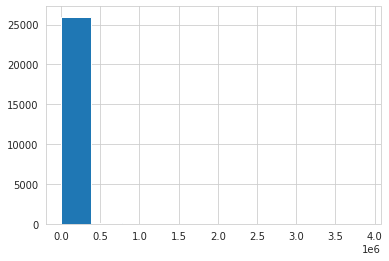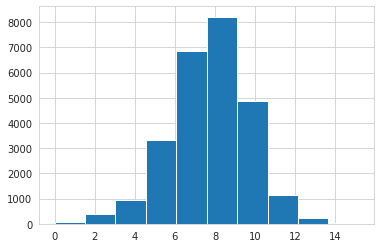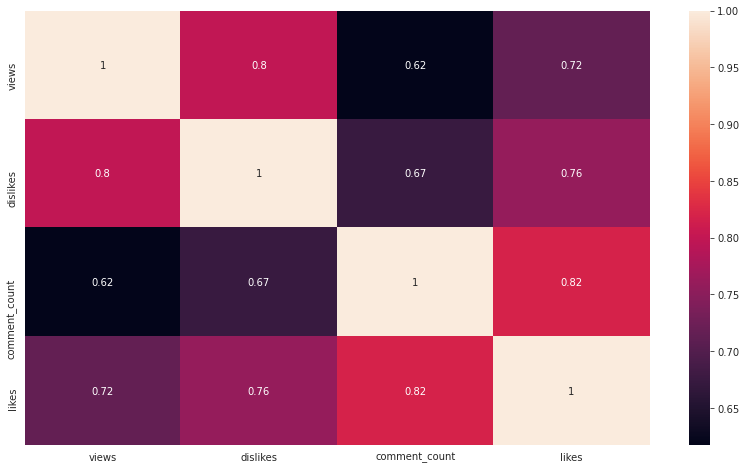HackLive II - Guided Community Hackathon
Go there and register to be able to download the dataset and submit your predictions. Click the button below to open this notebook in Google Colab!
As YouTube becomes one of the most popular video-sharing platforms, YouTuber is developed as a new type of career in recent decades. YouTubers earn money through advertising revenue from YouTube videos, sponsorships from companies, merchandise sales, and donations from their fans. In order to maintain a stable income, the popularity of videos become the top priority for YouTubers. Meanwhile, some of our friends are YouTubers or channel owners in other video-sharing platforms. This raises our interest in predicting the performance of the video. If creators can have a preliminary prediction and understanding on their videos’ performance, they may adjust their video to gain the most attention from the public.
You have been provided details on videos along with some features as well. Can you accurately predict the number of likes for each video using the set of input variables?
!pip install catboost
Requirement already satisfied: catboost in /usr/local/lib/python3.6/dist-packages (0.24.4)
Requirement already satisfied: graphviz in /usr/local/lib/python3.6/dist-packages (from catboost) (0.10.1)
Requirement already satisfied: matplotlib in /usr/local/lib/python3.6/dist-packages (from catboost) (3.2.2)
Requirement already satisfied: scipy in /usr/local/lib/python3.6/dist-packages (from catboost) (1.4.1)
Requirement already satisfied: six in /usr/local/lib/python3.6/dist-packages (from catboost) (1.15.0)
Requirement already satisfied: plotly in /usr/local/lib/python3.6/dist-packages (from catboost) (4.4.1)
Requirement already satisfied: pandas>=0.24.0 in /usr/local/lib/python3.6/dist-packages (from catboost) (1.1.5)
Requirement already satisfied: numpy>=1.16.0 in /usr/local/lib/python3.6/dist-packages (from catboost) (1.19.5)
Requirement already satisfied: python-dateutil>=2.1 in /usr/local/lib/python3.6/dist-packages (from matplotlib->catboost) (2.8.1)
Requirement already satisfied: cycler>=0.10 in /usr/local/lib/python3.6/dist-packages (from matplotlib->catboost) (0.10.0)
Requirement already satisfied: kiwisolver>=1.0.1 in /usr/local/lib/python3.6/dist-packages (from matplotlib->catboost) (1.3.1)
Requirement already satisfied: pyparsing!=2.0.4,!=2.1.2,!=2.1.6,>=2.0.1 in /usr/local/lib/python3.6/dist-packages (from matplotlib->catboost) (2.4.7)
Requirement already satisfied: retrying>=1.3.3 in /usr/local/lib/python3.6/dist-packages (from plotly->catboost) (1.3.3)
Requirement already satisfied: pytz>=2017.2 in /usr/local/lib/python3.6/dist-packages (from pandas>=0.24.0->catboost) (2018.9)
# import useful libraries
import numpy as np
import pandas as pd
import matplotlib.pyplot as plt
import seaborn as sns
sns.set_style("whitegrid")
from catboost import CatBoostRegressor
# load in data and set seed
BASE = 'https://drive.google.com/uc?export=download&id='
SEED = 2021
train = pd.read_csv(f'{BASE}1twZymRo0KT6IMIL7Q1wYoUSmHE3w3Buc')
test = pd.read_csv(f'{BASE}1Zu57FJCK4XpzX6_CzG_L4vlF9J73B9ke')
ss = pd.read_csv(f'{BASE}1s8iq0VaoTVkE9rQEAh1sfNuNdUgFjxYo')
# prepare a few key variables to classify columns into categorical and numeric
ID_COL, TARGET_COL = 'video_id', 'likes'
num_cols = ['views', 'dislikes', 'comment_count']
cat_cols = ['category_id', 'country_code']
text_cols = ['title', 'channel_title', 'tags', 'description']
date_cols = ['publish_date']
EDA starts
First we look at the first few rows of the train dataset.
train.head(3)
| video_id | title | channel_title | category_id | publish_date | tags | views | dislikes | comment_count | description | country_code | likes | |
|---|---|---|---|---|---|---|---|---|---|---|---|---|
| 0 | 53364 | Alif Allah Aur Insaan Episode 34 HUM TV Drama ... | HUM TV | 24.0 | 2017-12-12 | HUM|"TV"|"Alif Allah Aur Insaan"|"Episode 34"|... | 351430.0 | 298.0 | 900.0 | Alif Allah Aur Insaan Episode 34 Full - 12 Dec... | CA | 2351.0 |
| 1 | 51040 | It's Showtime Miss Q & A: Bela gets jealous of... | ABS-CBN Entertainment | 24.0 | 2018-03-08 | ABS-CBN Entertainment|"ABS-CBN"|"ABS-CBN Onlin... | 461508.0 | 74.0 | 314.0 | Vice Ganda notices Bela Padilla's sudden chang... | CA | 3264.0 |
| 2 | 1856 | ದರ್ಶನ್ ಗೆ ಬಾರಿ ಅವಮಾನ ಮಾಡಿದ ಶಿವಣ್ಣ ನಾಯಕಿ \n ಕ್... | SANDALWOOD REVIEWS | 24.0 | 2018-03-26 | challenging star darshan latest news|"challeng... | 40205.0 | 150.0 | 100.0 | ದರ್ಶನ್ ಗೆ ಬಾರಿ ಅವಮಾನ ಮಾಡಿದ ಶಿವಣ್ಣ ನಾಯಕಿ ಕ್ಲ... | IN | 580.0 |
ss.head(3)
| video_id | likes | |
|---|---|---|
| 0 | 87185 | 0 |
| 1 | 9431 | 0 |
| 2 | 40599 | 0 |
# look at distribution of target variable
train[TARGET_COL].hist();

Lots of zeroes! Definintely need to log transform to be able to analyse this variable. Luckily, GBDT regressors are resistant to log-normal distributions.
# look at distribution of target variable log-transformed
np.log1p(train[TARGET_COL]).hist();

# look at which variables are null and if they were parsed correctly
train.info()
<class 'pandas.core.frame.DataFrame'>
RangeIndex: 26061 entries, 0 to 26060
Data columns (total 12 columns):
# Column Non-Null Count Dtype
--- ------ -------------- -----
0 video_id 26061 non-null int64
1 title 26061 non-null object
2 channel_title 26061 non-null object
3 category_id 26061 non-null float64
4 publish_date 26061 non-null object
5 tags 26061 non-null object
6 views 26061 non-null float64
7 dislikes 26061 non-null float64
8 comment_count 26061 non-null float64
9 description 26061 non-null object
10 country_code 26061 non-null object
11 likes 26061 non-null float64
dtypes: float64(5), int64(1), object(6)
memory usage: 2.4+ MB
test.info()
<class 'pandas.core.frame.DataFrame'>
RangeIndex: 11170 entries, 0 to 11169
Data columns (total 11 columns):
# Column Non-Null Count Dtype
--- ------ -------------- -----
0 video_id 11170 non-null int64
1 title 11170 non-null object
2 channel_title 11170 non-null object
3 category_id 11170 non-null float64
4 publish_date 11170 non-null object
5 tags 11170 non-null object
6 views 11170 non-null float64
7 dislikes 11170 non-null float64
8 comment_count 11170 non-null float64
9 description 11170 non-null object
10 country_code 11170 non-null object
dtypes: float64(4), int64(1), object(6)
memory usage: 960.0+ KB
No nulls, which is great!
Looking at categorical columns
Because of a few categorical columns I decided to set a baseline in Catboost. Here are value counts and target variable boxplots for all of them, they prove useful.
# print top 5 value counts and plot target boxplots
for col in cat_cols:
print(f'Analysing: {col}\nTrain top 5 counts:')
print(train[col].value_counts().head(5))
print('Test top 5 counts:')
print(test[col].value_counts().head(5))
plt.figure(figsize=(20,5))
sns.boxplot(x=train[col], y=np.log1p(train[TARGET_COL]))
plt.show();
print('\n')
Analysing: category_id
Train top 5 counts:
24.0 9614
25.0 3725
22.0 2365
10.0 2099
23.0 1736
Name: category_id, dtype: int64
Test top 5 counts:
24.0 4105
25.0 1516
22.0 995
10.0 891
23.0 723
Name: category_id, dtype: int64

Analysing: country_code
Train top 5 counts:
IN 10401
CA 10326
US 3095
GB 2239
Name: country_code, dtype: int64
Test top 5 counts:
IN 4458
CA 4425
US 1327
GB 960
Name: country_code, dtype: int64

# channel title could be used as a high cardinality categorical variable
train['channel_title'].value_counts()
SAB TV 165
SET India 128
ESPN 122
Study IQ education 118
etvteluguindia 115
...
WGA West 1
PhantomStrider 1
Yarotska 1
KhalidVEVO 1
Christina Aguilera 1
Name: channel_title, Length: 5764, dtype: int64
# same with publish date
train['publish_date'].value_counts()
2018-01-29 199
2017-12-13 185
2018-01-19 181
2018-01-26 180
2018-01-12 179
...
2017-09-26 1
2015-10-31 1
2017-09-09 1
2015-05-21 1
2017-10-20 1
Name: publish_date, Length: 348, dtype: int64
Observations
Strange dataset, will remove textual features for now. Another template shows how to deal with them in the NLP template.
Canadian and Indian videos are the most common, where Canadian ones have more likes. There are fewer British and American ones, with British having the highest median likes.
Otherwise there is somewhat of a sine pattern in the likes distributions, we could maybe even use it as numerical. Let’s stick to categorising it for now.
Analysis of continuous variables
Let’s plot distributions and correlations for numerical variables.
# plot histogram and a kernel density plot of data wrt target variable (term deposit subscribed)
for col in num_cols+[TARGET_COL]:
print(f'Analysing: {col}')
fig, (ax1, ax2) = plt.subplots(1, 2, figsize=(20,5))
np.log1p(train[col]).hist(ax=ax1)
sns.kdeplot(np.log1p(train[col]), ax=ax2)
plt.show();
print('\n')
Analysing: views

Analysing: dislikes

Analysing: comment_count

Analysing: likes

# plot correlation heatmap
plt.figure(figsize=(14, 8))
sns.heatmap(np.log1p(train[num_cols+[TARGET_COL]]).corr(), annot=True);

%%time
# pairplots => these always take long to render
sns.pairplot(np.log1p(train[num_cols+[TARGET_COL]]));
CPU times: user 4.39 s, sys: 108 ms, total: 4.49 s
Wall time: 4.42 s
<seaborn.axisgrid.PairGrid at 0x7f09a5f48208>

Observations
All numerical columns are log-normal, views and dislikes highly correlated. Target likes are highly correlated with all numerical independent variables.
We could probably have a decent prediction just using these columns (hence dropping the text columns shouldn’t make a massive difference for now).
Baseline Model
Alright, after basic EDA of all variables, it’s time to introduce the basic Catboost model with no tuning as a baseline.
# data preparation
y = train[TARGET_COL].values
X = train.drop([TARGET_COL, ID_COL, 'title', 'tags', 'description'], axis=1)
X.head()
| channel_title | category_id | publish_date | views | dislikes | comment_count | country_code | |
|---|---|---|---|---|---|---|---|
| 0 | HUM TV | 24.0 | 2017-12-12 | 351430.0 | 298.0 | 900.0 | CA |
| 1 | ABS-CBN Entertainment | 24.0 | 2018-03-08 | 461508.0 | 74.0 | 314.0 | CA |
| 2 | SANDALWOOD REVIEWS | 24.0 | 2018-03-26 | 40205.0 | 150.0 | 100.0 | IN |
| 3 | doddleoddle | 10.0 | 2018-02-21 | 509726.0 | 847.0 | 4536.0 | GB |
| 4 | Dude Seriously | 23.0 | 2018-05-10 | 74311.0 | 69.0 | 161.0 | IN |
# categorical features declaration
cat_features = cat_cols + ['publish_date', 'channel_title']
cat_features
['category_id', 'country_code', 'publish_date', 'channel_title']
# fillnas and convert to right data types
print(X[cat_features].info())
X_filled = X.copy()
X_filled["category_id"] = X["category_id"].astype(np.int16)
X_filled[cat_features].info()
<class 'pandas.core.frame.DataFrame'>
RangeIndex: 26061 entries, 0 to 26060
Data columns (total 4 columns):
# Column Non-Null Count Dtype
--- ------ -------------- -----
0 category_id 26061 non-null float64
1 country_code 26061 non-null object
2 publish_date 26061 non-null object
3 channel_title 26061 non-null object
dtypes: float64(1), object(3)
memory usage: 814.5+ KB
None
<class 'pandas.core.frame.DataFrame'>
RangeIndex: 26061 entries, 0 to 26060
Data columns (total 4 columns):
# Column Non-Null Count Dtype
--- ------ -------------- -----
0 category_id 26061 non-null int16
1 country_code 26061 non-null object
2 publish_date 26061 non-null object
3 channel_title 26061 non-null object
dtypes: int16(1), object(3)
memory usage: 661.8+ KB
# import train test split, then split the data into train and test set
# cross validation is not included in the baseline => model could overfit
from sklearn.model_selection import train_test_split
X_train, X_validation, y_train, y_validation = train_test_split(X_filled, y, train_size=0.8, random_state=SEED, shuffle=True)
model = CatBoostRegressor(
loss_function='Tweedie:variance_power=1.9',
# Tweedie loss has worked wonders in previous kaggle comps modelling strange,
# Poisson-like distributions, it turns out to work well here as well
# more details here: https://stats.stackexchange.com/questions/492726/what-is-use-of-tweedie-or-poisson-loss-objective-function-in-xgboost-and-deep-le
random_seed=SEED, # set seed for reproducibility
eval_metric='MSLE', # set the same metric as in the competition
# task_type='GPU' # GPU does not work for Tweedie loss :/
)
model.fit(
X_train, y_train,
cat_features=cat_features,
use_best_model=True,
eval_set=(X_validation, y_validation),
verbose=50
)
print('Model is fitted: ' + str(model.is_fitted()))
print('Model params:')
print(model.get_params())
0: learn: 63.0488718 test: 63.3900575 best: 63.3900575 (0) total: 83ms remaining: 1m 22s
50: learn: 49.1816641 test: 49.4679398 best: 49.4679398 (50) total: 1.69s remaining: 31.5s
100: learn: 42.9424624 test: 43.2011343 best: 43.2011343 (100) total: 3.25s remaining: 28.9s
150: learn: 39.0388839 test: 39.2794343 best: 39.2794343 (150) total: 4.86s remaining: 27.3s
200: learn: 36.3599589 test: 36.5879924 best: 36.5879924 (200) total: 6.44s remaining: 25.6s
250: learn: 34.6895950 test: 34.9118270 best: 34.9118270 (250) total: 7.96s remaining: 23.7s
300: learn: 34.0791345 test: 34.3005940 best: 34.3005940 (300) total: 9.59s remaining: 22.3s
350: learn: 33.9920518 test: 34.2193143 best: 34.2193143 (350) total: 11.2s remaining: 20.7s
400: learn: 33.9895898 test: 34.2170543 best: 34.2010313 (380) total: 12.8s remaining: 19.2s
450: learn: 33.9986020 test: 34.2287529 best: 34.2010313 (380) total: 14.3s remaining: 17.4s
500: learn: 34.0068053 test: 34.2343207 best: 34.2010313 (380) total: 15.8s remaining: 15.7s
550: learn: 34.0136013 test: 34.2392720 best: 34.2010313 (380) total: 17.3s remaining: 14.1s
600: learn: 34.0192750 test: 34.2437817 best: 34.2010313 (380) total: 18.9s remaining: 12.6s
650: learn: 34.0238506 test: 34.2465844 best: 34.2010313 (380) total: 20.5s remaining: 11s
700: learn: 34.0270986 test: 34.2485531 best: 34.2010313 (380) total: 22.1s remaining: 9.44s
750: learn: 34.0302284 test: 34.2509902 best: 34.2010313 (380) total: 23.6s remaining: 7.84s
800: learn: 34.0324680 test: 34.2520011 best: 34.2010313 (380) total: 25.2s remaining: 6.26s
850: learn: 34.0348004 test: 34.2535832 best: 34.2010313 (380) total: 26.7s remaining: 4.68s
900: learn: 34.0367559 test: 34.2547111 best: 34.2010313 (380) total: 28.3s remaining: 3.11s
950: learn: 34.0383293 test: 34.2560061 best: 34.2010313 (380) total: 29.8s remaining: 1.54s
999: learn: 34.0399886 test: 34.2572126 best: 34.2010313 (380) total: 31.3s remaining: 0us
bestTest = 34.20103126
bestIteration = 380
Shrink model to first 381 iterations.
Model is fitted: True
Model params:
{'eval_metric': 'MSLE', 'random_seed': 2021, 'loss_function': 'Tweedie:variance_power=1.9'}
print('Tree count: ' + str(model.tree_count_))
Tree count: 381
model.get_feature_importance(prettified=True)
| Feature Id | Importances | |
|---|---|---|
| 0 | comment_count | 60.776699 |
| 1 | views | 20.077523 |
| 2 | dislikes | 12.546723 |
| 3 | category_id | 5.634881 |
| 4 | country_code | 0.964174 |
| 5 | channel_title | 0.000000 |
| 6 | publish_date | 0.000000 |
X_test = test.drop([ID_COL, 'title', 'tags', 'description'], axis=1)
X_test.head()
| channel_title | category_id | publish_date | views | dislikes | comment_count | country_code | |
|---|---|---|---|---|---|---|---|
| 0 | CHIRRAVURI FOUNDATION | 22.0 | 2018-01-17 | 80793.0 | 54.0 | 79.0 | IN |
| 1 | VIRAL IN INDIA | 22.0 | 2017-11-18 | 150317.0 | 230.0 | 311.0 | IN |
| 2 | Saskatchewan Roughriders | 17.0 | 2017-12-01 | 6558.0 | 10.0 | 7.0 | CA |
| 3 | Matthias Wandel | 26.0 | 2018-02-06 | 89664.0 | 145.0 | 324.0 | US |
| 4 | AVA Creative thoughts | 22.0 | 2018-02-06 | 53526.0 | 357.0 | 153.0 | IN |
# fillnas and convert to right data types TEST
print(X_test[cat_features].info())
X_test_filled = X_test.copy()
X_test_filled["category_id"] = X_test["category_id"].astype(np.int16)
X_test_filled[cat_features].info()
<class 'pandas.core.frame.DataFrame'>
RangeIndex: 11170 entries, 0 to 11169
Data columns (total 4 columns):
# Column Non-Null Count Dtype
--- ------ -------------- -----
0 category_id 11170 non-null float64
1 country_code 11170 non-null object
2 publish_date 11170 non-null object
3 channel_title 11170 non-null object
dtypes: float64(1), object(3)
memory usage: 349.2+ KB
None
<class 'pandas.core.frame.DataFrame'>
RangeIndex: 11170 entries, 0 to 11169
Data columns (total 4 columns):
# Column Non-Null Count Dtype
--- ------ -------------- -----
0 category_id 11170 non-null int16
1 country_code 11170 non-null object
2 publish_date 11170 non-null object
3 channel_title 11170 non-null object
dtypes: int16(1), object(3)
memory usage: 283.7+ KB
contest_predictions = model.predict(X_test_filled)
print('Predictions:')
print(contest_predictions)
Predictions:
[ 792.32025174 2267.42416482 313.2757626 ... 5558.09271849
11900.57430592 4262.99567486]
ss[TARGET_COL] = contest_predictions.round(0).astype(np.int16)
ss.head()
| video_id | likes | |
|---|---|---|
| 0 | 87185 | 792 |
| 1 | 9431 | 2267 |
| 2 | 40599 | 313 |
| 3 | 494 | 2833 |
| 4 | 73942 | 1074 |
ss.to_csv("catboost_baseline.csv", index = False)
# and we're done!
'Done!'
'Done!'